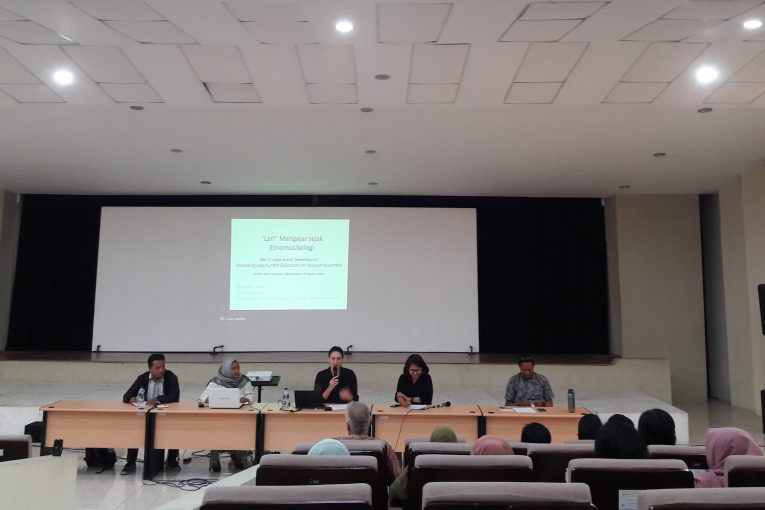
The workshop on Monday, August 19 2019, which was held at the ISI Yogyakarta Postgraduate School was quite different from the usual History Department event. Entitled Hidden Voices: Unpacking the Jaap Kunst’s Collection on the Music of Nusantara, this workshop was held in collaboration between the Department of History, FIB UGM and the Faculty of Performing Arts, ISI Yogyakarta. As the title implies, the purpose of the workshop is to discuss possible areas of research that can be studied about the legacy of a pioneer in modern ethnomusicology studies who made Nusantara music as the object of his study.
The workshop was filled by 10 speakers who were divided into three sessions. The first session began with a presentation on ethnomusicology from Dr. Barbara Titus. As the person who now occupies the position of the late Jaap Kunst as head of Ethnomusicology at the Universiteit van Amsterdam, he not only explains about Jaap Kunst’s legacy, but also criticizes and describes opportunities for ethnomusicology studies in the future. One panel with Barbara is Dr. Citra Aryandari and three of her students from ISI Yogyakarta. They shared the reasons for their interest in studying ethnomusicology.
The second session was filled by three people, namely RM Surtihadi, M.Sn., Indra Fibiona, S.S., and Dr. Sri Margana. Surtihadi who is also a doctoral student at ISI Yogyakarta explained about the mixing of Javanese and European music at the Yogyakarta Palace, while Indra Fibiona from the Yogyakarta Cultural Value Conservation Center (BPNB) explained the biography of R.M. Djajadipoera who during his lifetime often interacted with Jaap Kunst when he visited Yogyakarta. Djajadipoera is one of the music and dance figures at the Yogyakarta Palace. Sri Margana’s presentation from the UGM History Department focused more on his research on the archives of Djajadipoera’s correspondence with Jaap Kunst. Apart from directly watching music performances, Jaap Kunst also studied music through correspondence with many music experts and the two figures he wrote to the most were Mangkunegoro VII and Djajadipoera.
Furthermore, the third session was filled by Margi Ariyanti and Henk Mak van Dijk. Margi Ariyanti is a graduate student in the Study of Performing Arts and Fine Arts/ Pengkajian Seni Pertunjukan dan Seni Rupa (PSPSR) UGM, while Henk Mak van Dijk from the Music Conservatory of Rotterdam & the Royal Conservatory in The Hague. On that occasion, Margi tried to make a comparison between the famous Indo composer, Constant van de Wall, and Ki Hadjar Dewantara. Meanwhile, Henk who also teaches at the Muziek Academie, The Hague, spoke further about the career of one of the most successful composers. In 2007, he also published a biography of van de Wall. In addition to de Wall, Henk also mentions several composers who are similar to de Wall in mixing elements of Javanese music into European music, including a female composer born in Yogyakarta, Linda Bandara.
The ten speakers above did not only talk about Jaap Kunst individually, but also about ethnomusicology more broadly. This is in line with the event’s goal of developing, not just unlocking, the legacy of Jaap Kunst. In addition to the explanation of the knowledge requirements, the workshop participants were even more interested because the event was closed by Henk’s piano playing who performed compositions by Paul Seeling, van de Wall, and Linda Bandara. [sej/habibi]
